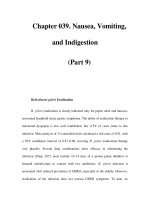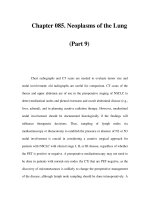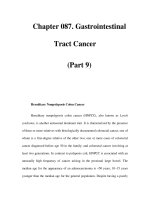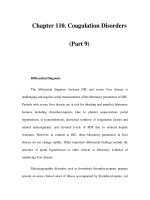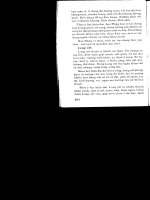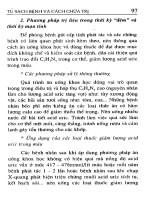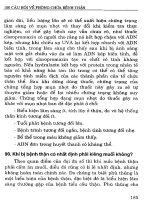Case files psychiatry - part 9 ppsx
Bạn đang xem bản rút gọn của tài liệu. Xem và tải ngay bản đầy đủ của tài liệu tại đây (192.5 KB, 48 trang )
368
CASE FILES: PSYCHIATRY
of treatment continues to be behavioral interventions. Family therapy
can be necessary to identify and address anxiety triggers and in helping the
child develop skills to lessen anxiety symptoms, for example, relaxation
techniques. School consultations can be helpful to aid in rapid, assertive
reintroduction of the child into the school setting. A successful transition
to separations should result in generous praise for the child.
Comprehension Questions
[48.1] A typical SSRI used in the treatment of separation anxiety disorder
includes which of the following?
A. Methylphenidate
B. Bupropion
C. Fluoxetine
D. Valproic acid
E. Imipramine
[48.2] Children or adolescents with separation anxiety disorder are at higher
risk for which other psychiatric disorder?
A. Malingering
B. Somatization disorder
C. Bipolar disorder
D. Learning disability
E. Major depression
[48.3] When starting an SSRI, such as fluoxetine, in an adolescent patient
with separation anxiety disorder, the Food and Drug Administration
(FDA) recommends the clinician monitor closely for which of the fol-
lowing?
A. Hypovolemia
B. Hypertension
C. Anorexia
D. Suicidal thoughts
E. Delusions
Answers
[48.1] C. This medication is one of several agents in the class collectively
called SSRIs. The other medications are not in this class and are not
used to treat separation anxiety disorder.
[48.2] E. Children and adolescents with separation anxiety disorder often
present with or later develop symptoms of major depression. In chil-
dren. this can include a depressed, sad, or irritable mood over an
extended period of time.
369 CLINICAL CASES
[48.3] D. The FDA recently placed a "black box" warning for the use of
antidepressants in children and adolescents. This warning reminds
clinicians of some evidence indicating a possible increased incidence
of suicidal thoughts among adolescents using antidepressants—
particularly SSRIs.
CLINICAL PEARLS
Separation anxiety disorder is often associated with a severe illness
of the caretaker, usually the mother.
This disorder often coexists with major depression, and this possi-
bility should be evaluated carefully.
The earlier separation anxiety disorder is treated, the better the
prognosis.
REFERENCES
Ebert M, Loosen P. Nurcombe B, eds. Current diagnosis and treatment in psychia-
try. New York: McGraw-Hill. 2000:579-580.
Kaplan H, Sadock B. Synopsis of psychiatry. 9th ed. Baltimore: Lippincott
Williams & Wilkins. 2003:1229-1235.
k
•;• CASE 49
A 45-year-old man is brought to the emergency department after a fight in the
bar where he has been employed for the past 3 weeks. The patient says that his
name is "Roger Nelson," but he has no identification. He states that he does
not know where he lived or worked prior to 3 weeks ago. although he does not
seem upset by this. He says that the fight broke out in the bar because one of
the customers attempted to steal money from the cash register.
On a mental status examination, the patient is seen to be alert and oriented
to person, place, and time. The results of all other aspects of the examination
are normal. A physical examination shows a 3-in-long laceration on the
patient's right forearm, which requires suturing. There is no head trauma or
any other abnormalities. When the police run a description check on the
patient, they find that he fits the description of a missing person, Charles
Johnson, who disappeared from a town 50 miles away 1 month prior to his
emergency department admission. Mrs. Johnson is able to identify Roger
Nelson as her husband. Charles. The patient claims not to recognize her, how-
ever, Mrs. Johnson explains that in the months prior to his disappearance, her
husband was under increasing work pressures and was afraid that he was going
to be fired. She says that the day before his sudden disappearance, her husband
had a huge fight with his boss. He came home and had a fight with her as well,
culminating in her calling him a "loser." She woke up the next morning to find
him gone. She states that the patient has no psychiatric history or problems and
denies that he uses drugs or alcohol. He has no medical problems.
• What is the most likely diagnosis for this patient?
• What are the course of and the prognosis for this disorder?
372
CASE FILES: PSYCHIATRY
ANSWERS TO CASE 49: Dissociative Fugue
Summary: A 45-year-old man is brought to the emergency department after a
fight in the bar where he is employed. Other than a laceration on his forearm,
there are no physical abnormalities. The results of his mental status examina-
tion are normal. The patient has been working at the bar for the past 3 weeks
but has no memory of his life prior to that. When his wife is located, the patient
does not recognize her. The wife reports that the patient has been missing for
1 month, his disappearance apparently precipitated by increasing problems at
work and fights with his boss and his wife. The patient has no history of psy-
chiatric problems, drug or alcohol use, or medical problems.
• Most likely diagnosis: Dissociative fugue.
+ Course and prognosis: Dissociative fugue is usually brief in duration,
lasting hours to days. Occasionally it lasts for months, and the patient
can travel thousands of miles from home. Generally, there is a rapid,
spontaneous recovery, and a recurrence after recovery is rare.
Analysis
Objectives
1. Recognize dissociative fugue in a patient (see Table 49-1 for diagnostic
criteria).
2. Understand the usual course of illness in this disorder.
Considerations
This man suddenly disappeared after experiencing a series of difficulties and
traumatic events in hi.s life. He appears suddenly several weeks later with a dif-
ferent name and a different life and does not recognize his wife. The results of
his mental status examination are otherwise normal. There is no history of a
dissociative identity disorder, drug use, or a general medical condition that
might better account for his behavior. Individuals experiencing dissociative
Table 49-1
DIAGNOSTIC CRITERIA FOR DISSOCIATIVE FUGUE
1. Unexpected, sudden departure from home and travel to a new location: the indi-
vidual is unable to recall his or her past.
2. The individual is not aware of his or her identity and may create a new one.
3. The condition does not occur in an individual with dissociative identity disorder
and is not caused by a medical condition or substance.
4. The condition must be distressing or impair social and/or occupational functioning.
373
CLINICAL CASES
fugue suddenly and unexpectedly travel far away from their homes and
cannot recall their previous identity or past. The person usually adopts a
new identity in the course of the fugue. Dissociation is a way in which peo-
ple defend themselves against overwhelming trauma: most instances of disso-
ciative fugue occur during times of war or other overwhelming disasters but
can also be triggered by severe marital, family, or occupational distress. It is a
rare disorder.
APPROACH TO DISSOCIATIVE FUGUE
Definitions
Depersonalization: Persistent or recurrent alteration of one's perception of
oneself as unreal or strange.
Dissociation: A form of defense against trauma: the individual "splits off
the memory of the traumatic event, emotions, thoughts, or behaviors,
which then exist on a "parallel" level of awareness.
Dissociative amnesia: Inability to recall specific information, usually
about one's identity, but having an intact memory about general infor-
mation: usually caused by a traumatic or stressful memory. This disor-
der does not involve traveling and adopting a new identity.
Dissociative identity disorder: Commonly known as multiple personality
disorder, a disorder in which a person invents multiple personalities to
help deal with a traumatic event, usually one that has occurred in child-
hood. Two or more identities or personality states recurrently take con-
trol of the person's behavior.
Clinical Approach
Severely traumatic events, such as those occurring during a war, or intense
personal crises can precipitate these rare events. Individuals affected by disso-
ciative fugue display more purposeful behavior than those with dissociative
amnesia. They travel away from their families, take on new identities, and
often new occupations. Alcohol abuse and certain mood and personality dis-
orders can predispose one to this disorder but are not the cause.
Differential Diagnosis
The main purpose of dissociative fugue appears to be escape from a traumatic
experience; therefore there is always a history of the occurrence of an over-
whelming event in these cases. However, a clinician faced with such patients is
unlikely to be aware of this history, as the patients have blocked the events from
their memories. The clinician must therefore consider and rule out other diag-
noses. In dissociative amnesia, individuals lose their memory of the past but do
not leave home or invent a new identity. In dissociative identity disorder, the
374
CASE FILES: PSYCHIATRY
patient experiences himself or herself as at least two separate identities with
individual behaviors, emotions, and histories.
Patients with dementia or delirium have memory problems and can
wander far from home, but their travels are purposeless and disorganized,
and they do not invent new identities. Patients with complex partial seizures
can travel away from home, but they do not invent new identities, and there is
usually no history of a traumatic event. Patients with bipolar disorder expe-
riencing an episode of mania often travel far from home, but they are often
delusional, have hallucinations, and display other symptoms of bipolar illness.
Intoxication caused by many different substances can cause amnesia and result
in sudden travel; alcohol and hallucinogens, in addition to barbiturates, ben-
zodiazepines, steroids, and phenothiazines, can all produce retrograde amne-
sia. Another possibility is malingering, that is, falsifying a fugue to obtain
some gain, such as to escape creditors or drug dealers.
Treatment
There is no indicated psychopharmacologic treatment for dissociative fugue,
although an interview under Amytal Sodium (amobarbital sodium) or a ben-
zodiazepine can render helpful diagnostic information. It is generally treated
by first obtaining a complete psychiatric history, perhaps aided by the use of
hypnosis, so that the psychological stressors that precipitated the fugue can
be discovered. On identification of the precipitating event, psychodynamic
psychotherapy is typically helpful in helping the patient deal with the stres-
sor in a more healthy, integrated way to minimize the risk of a dissociative
recurrence.
Comprehension Questions
[49.1] A man who appears to be approximately 70 years of age is brought to
the emergency department by the police. He was picked up after he
tried to order food in a restaurant but had no money to pay the bill. He
is oriented to place and time and gives his name as "Bill," but he can-
not remember where he lives, his telephone number, or the names of
his family members. He does recall that he served in the Pacific during
World War II and that he was raised in rural New Hampshire. The
results of his physical examination are essentially normal, and his rou-
tine laboratory tests reveal mild anemia. Which of the following is the
most likely diagnosis?
A. Dissociative amnesia
B. Dissociative fugue
C. Alcohol dependence
D. Dementia
375
CLINICAL CASES
[49.2] Dissociative fugue is distinguished from dissociative amnesia by
which of the following?
A. The presence of retrograde amnesia
B. Travel far from home or family
C. A precipitating traumatic event
D. Creation of multiple identities
[49.3] A 38-year-old woman has adopted a new identity in a city 120 miles
away from her hometown and has no memory of her prior life.
Apparently, this event was precipitated by confrontation of her addic-
tion to gambling and a threat of divorce. Which of the following is
most likely to be an associated factor in her illness?
A. History of head trauma
B. Paranoid personality disorder
C. Birth of a baby within 3 months
D. Female gender
Answers
[49.1 ] D. Dementia. This patient has preserved some past memory, which is
characteristic of dementia but not of dissociative fugue or amnesia. If
he had a history of alcoholism, there would be some evidence from his
physical examination (or in his blood alcohol level).
[49.2] B. Travel far from one's home or family distinguishes dissociative
fugue from dissociative amnesia; both are precipitated by trauma and
are characterized by retrograde amnesia. In neither dissociative fugue
nor dissociative amnesia are multiple identities created, as they are in
dissociative identity disorder.
[49.3] A. A history of head trauma predisposes one to dissociative fugue.
CLINICAL PEARLS
Dissociative fugue is rare, and several disorders must be considered
and ruled out before it is definitively diagnosed.
Interviews conducted under hypnosis or Amytal Sodium (amobar-
bital sodium) or benzodiazpines can confirm the diagnosis if a
corroborative history is lacking.
376
CASE FILES: PSYCHIATRY
REFERENCES
Kapur N. Amnesia in relation to fugue states: distinguishing a neurological form
from a psychogenic basis. Br J Psychiatry 1991;159:872-873.
Saxe GN, van der Kolk VA, Berkowitz R, et al. Dissociative disorders in psychiatric
inpatients. Am J Psychiatry 1993:150:1037-1039.
Chefetz R. ed. Neuroseientific and therapeutic advances in dissociative disorders.
Psychiatric Annals 2005;35(8):657-665.
•> CASE 50
A 16 year-old girl comes to the emergency department at the insistence of her
parents with a chief complaint of suicidal ideation. She states that for the past
week she has felt that life is no longer worth living and that she has been plan-
ning to kill herself by getting drunk and taking her mother's Xanax (alprazo-
lam). She says that her mood is depressed, she has no energy, and she is not
interested in doing things she normally enjoys. Prior to 1 week ago, she had none
of these symptoms. The patient states that she has been sleeping 12 to 14 hours
a day for the past week and eating "everything in sight." She says she has never
been diagnosed with major depression or has been seen by a psychiatrist and
that she has no medical problems of which she is aware. The patient states that
up until 9 days ago she used cocaine on a daily basis for a month and then
stopped it when school started.
On a mental status examination, the patient appears alert and oriented to
person, place, and time. Her speech is normal, but her mood is "depressed"
and her affect is constricted and dysphoric. She denies having hallucinations
or delusions but has suicidal ideation with a specific intent and plan. She
denies having homicidal ideation.
• What is the most likely diagnosis for this patient?
• What is the next step in the treatment?
378
CASE FILES: PSYCHIATRY
ANSWERS TO CASE 50: Substance-Induced
Mood Disorder
Summary: A 16-year-old patient presents to the emergency department with
suicidal ideation 9 days after she stopped using cocaine. Since 1 week ago, she
has noted a depressed mood, hypersomnia, decreased energy, anhedonia, and
an increased appetite. She has no medical problems and has never been diag-
nosed with major depression. On a mental status examination, her mood is
seen to be depressed, and her affect is dysphoric and constricted. She has sui-
cidal ideation with a specific intent and a plan.
• Most likely diagnosis: Substance-induced mood disorder (cocaine
withdrawal).
+ Next step: Discontinuing use of the offending drug is usually enough
to cause the mood disorder symptoms to abate. An antidepressant is
generally not needed initially, however, if the depressive symptoms
continue, treatment with an antidepressant can be indicated. This
patient certainly needs substance abuse treatment to deal with her
substance abuse problems. A more detailed substance abuse history
should be taken.
Analysis
Objectives
1. Recognize substance-induced mood disorder (see Table 50-1 for
diagnostic criteria).
2. Know the treatment recommendations for a patient with this disorder.
Table 50-1
DIAGNOSTIC CRITERIA FOR SUBSTANCE-INDUCED MOOD
DISORDER
1. A persistent, prominent disturbance in mood characterized by either (or both) of the
following: (a) a depressed mood or markedly decreased interest or pleasure in
activities thai are usually enjoyable, or (b) an elevated, expansive, or irritable mood.
2. An indication from the patient's history, a physical examination, or laboratory
results that the symptoms developed during or within a month of substance intoxi-
cation or withdrawal. The symptoms can also be related lo the use of a medication.
3. Sufficient evidence is not present indicating that ihe mood disorder is not
substance-induced. This evidence might include symptoms that started before use of
the substance, symptoms that persisted well beyond (more than a month) the period
of intoxication or withdrawal, symptoms in excess of what would be expected for
the type and amount of substance used, or a history of major depression.
5. Symptoms do not occur only during the course of a delirium.
379
CLINICAL CASES
Considerations
The primary consideration in this case is that the patient did not start having
mood symptoms until after she stopped taking cocaine. On withdrawing from
the drug, the patient noted a severely depressed mood with suicidal ideation.
In addition, she noted many of" the signs/symptoms of cocaine withdrawal,
including fatigue, decreased energy, hypersomnia, and an increased appetite.
The patient has no history of major depression.
APPROACH TO SUBSTANCE-INDUCED MOOD
DISORDER
Definitions
Anhedonia: Loss of interest or pleasure in normally enjoyable activities
Hyperactivity: Excessive level of activity significantly above that expected
for the developmental stage and setting
Hypersomnia: An increase in the amount of sleep (and a subjective feel-
ing of a need for sleep) above what is normal for a particular person
Impulsivity: Taking action without appropriate thought and consideration,
which often leads to a dangerous situation
Clinical Approach
Cocaine has been used at least once by 25 million people in the United Sates
with 2.7% of the population having had cocaine dependence at one time.
(The lifetime prevalence of bipolar disorder is only 1.6%.) Cocaine-induced
mood disorder can occur during use, intoxication or withdrawal from the
drug. During use and intoxication, cocaine is more likely to produce a
manic state; depressed states are more common during withdrawal.
Substances, including medications used to treat nonpsychiatric disorders,
neuroactive chemicals, or recreational agents can induce mood changes.
Antihypertensive agents especially are commonly causative. Depression,
mania with or without psychotic symptoms, or mixed depression and mania
can result. Both intoxication with and withdrawal from a substance can lead to
a mood disturbance.
Differential Diagnosis
Care must be taken to determine if substance intoxication or substance with-
drawal is currently present. Realize that patients will often lie to health care
providers regarding their substance use. A toxicology screen and ancillary history
from family and friends can be extremely helpful in determining actual substance
use patterns. If no substance use is identified, a primary mood disorder or
depressive disorder not otherwise specified (NOS) should be considered. Mood
380
CASE FILES: PSYCHIATRY
disorder caused by a general medical condition is diagnosed if a medical condi-
tion is thought to account for the depressive symptoms. Finally, a careful review
of the patient's history should indicate whether episodes of mania or depression
have occurred, and if so, a diagnosis of bipolar disorder should be considered.
Treatment
The main treatment for a substance-induced mood disorder is cessation of use
of the causative substance. This is particularly true of alcohol and opioids. On
the other hand, cessation of the use of some substances can initially result in a
worsening of mood: for instance, discontinuing cocaine use often leads to a
"crash," which quite commonly includes a severely dysphoric mood. However,
even in such cases, the vast majority of mood symptoms resolve on their own
without psychopharmacologic intervention, usually within several weeks. If
the symptoms of a substance-induced mood disorder do not resolve with
removal of the offending substance, the use of psychotropic medications can
be indicated. For example, a patient with this disorder who remains depressed
should be treated like a patient with major depression and given antidepressant
medication. A patient whose substance-induced mood disorder takes the form
of a manic presentation should be treated like a patient with bipolar disease
and given a mood stabilizer.
Referral for substance abuse treatment is always indicated. Many patients
need more than 10 attempts at substance abuse treatment in order to finally
achieve sobriety.
Comprehension Questions
[50.1 ] Mood disturbances associated with substances can best be described as
which of the following?
A. Euthymic
B. Primarily depressed
C. Primarily manic
D. Fluctuating between depressed and manic
E. Substance-specific
[50.2) Which of the following is true of substances that can cause a
substance-induced mood disorder?
A. The substance can be a medication prescribed by a physician.
B. The substance is almost always of an illicit nature.
C. It does not matter whether the symptoms are related to the intoxi-
cation state.
D. It does not matter whether the symptoms are related to the with-
drawal state.
E. The substance should not produce any pleasurable effects for the user.
381
CLINICAL CASES
(50.3] A 23-year-old male comes in to see you because he thinks he is "going
crazy." He states that he feels that things around him are "unreal" and
that he is "fading out at times." He denies having hallucinations. On
examination, he appears relaxed and has reddened conjunctivae. Which
of the following is most likely to clarify that drug use is a problem?
A. Physical exam
B. Mental status exam
C. Urine toxicology screen
D. Serum liver panel
E. Magnetic resonance imaging of brain
Answers
[50.1 ] E. Substances vary in their effect on mood. For example, alcohol is pri-
marily a depressant, whereas cocaine can cause euphoria over the short
term, but generally depression as it is eliminated from the body and
withdrawal is experienced.
[50.2] A. Many medications prescribed by physicians have an effect on mood
and might be the cause of mood symptoms or a disorder. The substance
need not be illicit and can produce many pleasurable effects during the
intoxication state. The disorder should not be diagnosed if the intoxi-
cation or withdrawal state is still present.
[50.3] C. Urine toxicology screens are extremely important to obtain in the
emergency center setting.
CLINICAL PEARLS
The symptoms can occur during the period of time the substance is
being used or up to a month after use of the substance has ceased.
In order for the mood symptoms to be accurately assessed, the
patient should not be acutely intoxicated or undergoing the with-
drawal process.
REFERENCES
Jaffe JH. Cocaine-related disorders. In: Sadock BJ, Sadock VA. eds. Kaplan and
Sadock's comprehensive texibook of psychiatry. 7th cd. Philadelphia: Lippincott
Williams & Wilkins, 2000:999-1015.
Jaffe JH. Introduction and overview of substance-related disorders. In: Sadock BJ.
Sadock VA. eds. Kaplan and Sadock's comprehensive textbook of psychiatry.
7th ed. Philadelphia: Lippincott Williams & Wilkins, 2000:924-952.
••• CASE 51
A 30-year-old woman comes to a psychiatrist with a chief complaint of "I
can't seem to finish my PhD." She claims that she has been working on her
thesis for the last 5 years but has procrastinated to the point where it seems as
if she will not finish it any time soon. Likewise, it took her 6 years to finish
college. She says that she sometimes worries that "I'm all messed up" but can
only relate this to her general unhappiness with her progress on her thesis and
her lack of a long-term love relationship. She states that she is tired of this and
wants to "get to the bottom of why I do this to myself." The patient notes that
she is doing fine otherwise. She has no problems with sleep, appetite, concen-
tration, or energy level. Her mood has been fine, and she is interested in
numerous hobbies. She has no psychiatric history, and her only medical prob-
lem is mild hypertension that is well controlled by a diuretic. She lives alone
in an apartment with her cat and supports herself by working for the physiol-
ogy laboratory where she is working on her thesis. She states that she has a
good relationship with her parents, who were divorced when she was 9 years
old. The patient denies using drugs and drinks two or three glasses of red wine
a week because "I was told it is good for my heart." The results of her mental
status examination are entirely within normal limits.
• What is the most likely diagnosis?
• What treatment should be suggested for this woman?
384
CASE FILES: PSYCHIATRY
ANSWERS TO CASE 51: Neurosis
Summary: A 30-year-old woman presents with a chief complaint of being
unable to finish her thesis. She had difficulty finishing college in 4 years as
well. She is afraid that there is something wrong with her. although she can-
not pinpoint exactly what it is. She also lacks a long-term love relationship,
although she would like to have one. Otherwise, the patient has no psychiatric
signs or symptoms. She has no psychiatric history, and her only medical prob-
lem is well-controlled hypertension. Her parents were divorced when she was
9 years old. The patient has no history of drug use and drinks two or three
glasses of red wine a week.
• Most likely diagnosis: No diagnosis is listed in the Diagnostic and
Statistical Manual of Mental Disorders, text revision (DSM-IV-TR).
(The patient might be considered neurotic.)
• Best treatment: Insight-oriented psychotherapy or psychoanalysis.
Analysis
Objectives
1. Recognize neurotic symptoms in a patient when there is no DSM-IV-
TR diagnosis.
2. Understand the treatment recommended for a patient with neurosis.
Considerations
This patient exhibits the classic Freudian problems of a patient with neurosis—
"trouble working and loving." She procrastinates as a matter of course,
resulting in her taking longer than usual to finish college and to complete
her thesis. She lacks a long-term love relationship, although she would like
one. She has insight into the fact that something that she is doing to herself
is causing these problems. Otherwise, she has no signs or symptoms of a
DSM-IV-TR disorder, and the results of her mental status examination are
normal.
APPROACH TO NEUROSIS
Definitions
Insight-oriented psychotherapy: A type of therapy derived from psycho-
analytic principles, but the frequency of the sessions can be once or
twice a week and the length of the treatment can be as short as several
385
CLINICAL CASES
weeks. The goal is still "to make the unconscious conscious," but on a
more limited scale and in relation to a circumscribed life problem.
Neurosis: A central concept of psychoanalytic theory that describes "prob-
lems in living" not currently part of the DSM-IV-TR. It is a chronic.
nonpsychotic condition characterized by anxiety. The anxiety can be
expressed by way of defense mechanisms, becoming symptoms such as
sexual inhibitions, phobias, or obsessions. Neurotic symptoms are
thought to be caused by an unconscious conflict that generates anxiety;
symptoms develop when an individual's defenses cannot adequately cope
with this anxiety. The unconscious conflicts can involve forbidden wishes
or feelings, which usually have roots in the individual's early develop-
ment. For example, the woman cited in the case described can have an
unconscious conflict about both competing in the professional world and
seeking a love relationship: that is, she feels guilty about her wish to suc-
ceed in both, as if success in one would result in failure in the other.
Psychoanalysis: Freud created psychoanalysis for the treatment of neu-
rotic symptoms. It is an intensive therapy usually involving an hour
of therapy for 4 or 5 days a week over several years. The goal is to
"make the unconscious conscious." Ideally, once patients have gained
a full understanding of the roots of their unconscious fears and
wishes, they are able to live life more fully. Psychoanalysis is used to
treat individuals with neurotic or character pathology—but not those
with psychoses or severe depression. It is demanding in terms of time
and money, and so the patient must be functioning reasonably well in
many areas of life.
Clinical Approach
The individual must experience chronic symptoms of anxiety—or anxiety
expressed as inhibitions, fears, phobias, or obsessions—that he or she consid-
ers distressing and not acceptable. The anxiety or other symptoms must cause
mild to moderate impairment in the individual's work and/or interpersonal life.
There must be no psychotic disorder or other axis I or II disorder that can
account for the anxiety, and no medical condition or substance use that can
explain the condition.
Differential Diagnosis
Neurosis is not listed in the DSM-IV-TR, and there can be considerable over-
lap between patients who are considered to have a neurosis and those with
generalized anxiety disorder (GAD). In a neurosis, there is usually evidence
in the patient's history of an intrapsychic conflict, such as discomfort with
achieving success in work. In contrast, patients with GAD can describe them-
selves as always having been anxious, with no particular focus or area of life
386
CASE FILES: PSYCHIATRY
as a nodal point. Neurotic obsessions or compulsions can mimic those of
obsessive-compulsive disorder (OCD), but individuals with OCD do not have
premorbid compulsive symptoms. Neurotic obsessions and compulsions are
not as severe and are consistent with lifelong character traits.
In general, neurotic patients have no psychiatric history and function rea-
sonably successfully overall; problems occur in a more circumscribed area
of the personality. Patients with borderline personality disorder complain of
some of the same symptoms but have serious problems identifying and
managing their emotions (especially anger), lack a firm sense of self, and
have a history of tumultuous relationships with others. They usually have a
history of impulsive behavior, including self-destructive gestures or suicide
attempts.
Treatment
Psychoanalysis or intensive psychodynamic therapy is the treatment of
choice for neurosis. The unconscious meaning of symptoms becomes evi-
dent in the course of treatment, allowing the patient freedom to think, feel,
and behave in ways more conducive to achieving life goals and ambitions.
The process can be long-term in nature and does not follow a predeter-
mined course; rather, the therapist works with the patient through typically
45-minute sessions to discover how the patient thinks and feels about the
world. The theory is that this particular mode of thinking and feeling devel-
oped as a reaction to childhood events and to the environment in which the
child found himself or herself. Although the particular ways of reacting to
the world were adaptive in childhood, they have since become rigid and
inflexible and are used in every situation in adulthood, thus precipitating
neurotic symptoms and other "clashes" with the outside world. For exam-
ple, a patient tells his therapist about his father and the unpredictable, harsh,
and often punitive attitude his father had toward his son. As an adaptive
response in childhood, the boy learned to be meek and to see authority fig-
ures as dangerous and something to be avoided. Although this worked well
in allowing him to survive his childhood, it does not work well in the pres-
ent, where as a man he is asked to be assertive with his bosses and col-
leagues, something he finds almost impossible. In psychotherapy, he learns
about the coping skills he developed as a child, and after discussing with the
therapist his feelings of anxiety about trying something else, he discovers
that there are ways to approach authority figures other than the only one he
thought was available.
387
CLINICAL CASES
Comprehension Questions
[51.1] A 27-year-old female teacher with no psychiatric history comes in for
treatment with the complaint that a recent relationship with a boyfriend
has failed: she states that she has had long-standing problems maintain-
ing relationships with men and wishes to find "a solution." Since the
breakup 4 weeks previously, she has had difficulty getting to sleep and
frequently wakes up at 3 A.M. She has no appetite and has lost 7 lb. She
complains that her concentration in the classroom has deteriorated, that
she has lost interest in her students, and that she often has crying spells
during the day. She has withdrawn from friends and colleagues recently.
Which one of the following diagnoses must the clinician consider first?
A. Sleep disorder
B. Major depression
C. Neurosis
D. Eating disorder
[51.2] A 24-year-old male engineering student comes to the counseling cen-
ter because of "problems with sex." He is heterosexual, is attracted to
women, and is able to begin casual relationships. He experiences nor-
mal sexual excitement, but when the opportunity for intercourse
occurs, he becomes anxious and cannot maintain an erection. He can
masturbate without difficulty, and his family physician has told him
that he is "completely normal physically." The man states that his
father was a military officer who was absent for several years when the
patient was in his early school years: the patient was an only child who
was very close to his mother. He has no psychiatric history. Which of
the following is the most appropriate treatment for this patient?
A. Cognitive behavioral therapy (CBT)
B. Antidepressant medication
C. Psychodynamic psychotherapy
D. Interpersonal therapy
[51.3] Which of the following best describes the difference between a neu-
rotic patient and a patient with a personality disorder?
A. Neurotic patients are less functional than patients with a personal-
ity disorder.
B. Neurotic patients believe that their problems stem from inside them-
selves, whereas patients with personality disorders believe that their
problems are the result of interactions with the people around them.
C. Patients with personality disorders are more easily treated with
antidepressants than are neurotic patients.
D. Patients with personality disorders tend to be more motivated to
seek psychotherapy than are neurotic patients.
E. Psychotherapy tends to be more successful with patients with per-
sonality disorders than with neurotic patients.
388
CASE FILES: PSYCHIATRY
Answers
[51.1] B. Although there can indeed be a neurotic conflict underlying the
patient's difficulty with men, she currently has symptoms of major
depression that must be treated before intensive dynamic psychother-
apy or psychoanalysis can be considered. Her weight loss is not severe
and occurs in the context of the depression. Her sleep problems are
also part of the depressive picture.
[51.2] C. Psychodynamic psychotherapy is indicated for this young man, who
has a circumscribed conflict about performing sexually. Although addi-
tional history is needed, there is a suggestion that early conflicts about
sexuality arose because his father was absent from the home at a time
when normal children entertain fantasies about marrying the parent of
the opposite sex. The patient is not depressed, and neither CBT nor
interpersonal therapy is likely to elicit the unconscious conflict trou-
bling him.
[51.3] B. Neurotic patients see their symptoms as ego-dystonic, that is, objec-
tionable behavior coming from within themselves. Patients with per-
sonality disorders, in contrast, see their symptoms as ego-syntonic, that
is, objectionable behavior coming from others, not themselves.
CLINICAL PEARLS
Neuroses are seen in individuals who are generally doing well in
life although they are distressed by their symptoms. They can
identify and manage their emotions, have generally good inter-
personal relationships, and have a stable sense of self.
Psychodynamic psychotherapy is often helpful in treating individu-
als who are neurotic.
REFERENCES
Gabbard GO, Psychoanalysis. In: Sadock BJ, Sadock VA, eds Comprehensive text-
book of psychiatry, 7th ed., vol I. Baltimore: Lippincott Williams & Wilkins,
2000:563-566.
Gabbard GO. Psychodynamic psychiatry in clinical practice, 3rd ed. Washington,
DC: American Psychiatric Press, 2000:35-173.
<• CASE 52
Eight hours after a psychiatric admission because of suicidal ideation, a 32-year-
old woman begins to complain of feehngjittery and shaky. Six hours later, she
tells staff members that she is hearing the voice of a dead relative shouting at
her, although on admission she denied ever having heard voices previously.
She complains of an upset stomach, irritability, and sweatiness. Her vital signs
are blood pressure 150/95 mm Hg, pulse rate 120/min, respirations 20/min,
and temperature 100.0°F (37.8°C). The patient reports no significant medical
problems and says that she takes no medications.
• What is the most likely diagnosis?
• What is the next step in the treatment of this disorder?
390
CASE FILES: PSYCHIATRY
ANSWERS TO CASE 52: Alcohol Withdrawal
Summary: Eight hours after admission to a hospital, a 32-year-old woman
complains of feeling shaky. Six hours later, she is irritable, has gastrointestinal
disturbances and hallucinations, and is diaphoretic. She is hypertensive, mildly
febrile, and tachycardic. She reports no previous medical problems.
^ Most likely diagnosis: Alcohol withdrawal.
• Next step in treatment: The patient should be treated with a
benzodiazepine immediately, starting with high doses and tapering as
she recovers.
Analysis
Objectives
1. Recognize the symptoms of alcohol withdrawal in a patient (see
Table 52-1 for diagnostic criteria).
2. Be aware of the treatment recommendations that should be instituted
immediately in a patient with this disorder.
Considerations
Because of her admission to the hospital, this patient was unable to continue
her alcohol intake, and 8 hours after her last drink, she began to experience the
signs and symptoms of alcohol withdrawal, which then worsened over the next
6 hours.
Table 52-1
DIAGNOSTIC CRITERIA FOR ALCOHOL WITHDRAWAL
• Cessation of or reduction in heavy, prolonged, alcohol use.
• Two or more of the following develop within hours to days:
1. Autonomic hyperactivity
2. Hand tremor
3. Insomnia
4. Nausea or vomiting
5. Transient hallucinations
6. Agitation
7. Anxiety
8. Seizures
• The symptoms cause distress or impairment in functioning.
• The symptoms are not due to a general medical condition or to another mental
disorder.
391
CLINICAL CASES
APPROACH TO ALCOHOL WITHDRAWAL
Definitions
Diaphoresis: Excessive sweating.
Sympathomimetic: A substance that mimics at least some adrenalin or
catecholamine responses. Examples of sympathomimetic substances
include coffee, ephedrine, and amphetamines.
Clinical Approach
Alcohol functions as a depressant much like benzodiazepines and barbiturates.
It has an effect on serotonin and gamma-aminobutyric acid type A (GABA-A)
receptors, producing tolerance and habituation. Withdrawal symptoms usually.
but not always, occur in stages: tremulousness or jitteriness (6 to 8 hours), psy-
chosis and perceptual symptoms (8 to 12 hours), seizures (12 to 24 hours), and
delirium tremens (DTs) (24 to 72 hours). Notably, alcohol withdrawal, par-
ticularly DTs can be fatal.
Differential Diagnosis
Included in the differential diagnosis for alcohol withdrawal are other drug
withdrawal states, especially sedative-hypnotic withdrawal. In fact, the criteria
for withdrawal from substances such as benzodiazepines (most commonly
short-acting, high-potency drugs) and barbiturates are identical to those for
alcohol withdrawal. A carefully recorded history, a physical examination, and
laboratory results indicative of long-term, heavy, alcohol use (e.g., evidence of
cirrhosis or liver failure, macrocytic anemia, elevated liver transaminase lev-
els) will point to the correct diagnosis.
Medical conditions with similar signs and symptoms must be ruled out.
Examples of such conditions include thyroid storm (thyrotoxicosis), pheochro-
mocytoma. and inappropriate use of beta-agonist inhalers or sympathomimetics.
Although hallucinations are rare in alcohol withdrawal without delirium, if
present they can be confused with those of schizophrenia. Several features dis-
tinguish the two conditions: In alcohol withdrawal, the perceptual disturbances
are transient, there is not necessarily a history of a psychotic illness, the asso-
ciated symptoms of schizophrenia are not present, and the patient's reality test-
ing ability remains intact.
Treatment
Severe alcohol withdrawal with autonomic instability (DTs) has a high
mortality and requires stabilization in an acute medical facility. The most
common treatment for alcohol withdrawal remains benzodiazepines,
392
CASE FILES: PSYCHIATRY
administered either orally or parenterally. If liver function is not impaired,
a long-acting benzodiazepine such as chlordiazepoxide or diazepam can be
given, although these drugs are absorbed erratically when injected and
should be given orally. If there is concern about decreased liver function, a
benzodiazepine such as oxazepam or lorazepam can be administered either
orally or parenterally, as their metabolism is not dependent on liver func-
tion. Whatever the specific drug used, it should be given as frequently as
necessary in order to normalize the vital signs and sedate the patient. The
medicine should then be gradually tapered over the next several days, and
the patient's vital signs monitored. Anticonvulsants such as carbamazepine
and valproic acid are also effective in treating alcohol withdrawal, although
it is a much less popular option in the United States given familiarity with
treatment with benzodiazepines.
Comprehension Questions
[52.1] Which of the following signs is most characteristic of alcohol
withdrawal?
A. Decreased blood pressure
B. Hypersomnia
C. Persistent hallucinations
D. Tremor
[52.2] Withdrawal from which of the following substances shares a similar
presentation with withdrawal from alcohol?
A. Alprazolam
B. Cocaine
C. Heroin
D. Lysergic acid diethylamide (LSD)
[52.3| Activation of what neurotransmitter system is used most often in treat-
ing alcohol withdrawal?
A. Dopaminergic
B. GABA
C. Noradrenergic
D. Serotonergic
